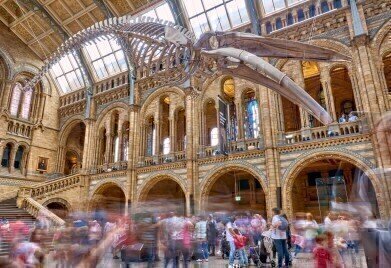-
 A new science and digitisation centre for the Natural History Museum will be located at Harwell. (Credit: Natural History Museum)
A new science and digitisation centre for the Natural History Museum will be located at Harwell. (Credit: Natural History Museum)
News & Views
Centre to Future Proof Natural History Collections
Mar 20 2020
A new £180 million science and digitisation centre for the UK’s Natural History Museum, announced in the Government’s 2020 Budget (March 11), is to be based at the Harwell Science and Innovation Campus close to STFC’s Central Laser Facility, ISIS Neutron and Muon Source and the UK’s national synchrotron Diamond Light Source.
The new facility will act as a sustainable base for natural sciences research and international collaboration, strengthening the UK’s position in tackling global challenges including climate change, resource scarcity, biodiversity loss and emerging diseases. The campus is home to a scientific community of over 6,000 people and thrives on its proximity to the UK’s national laboratories managed and developed by STFC.
The new centre will house around 40% of the of the Museum’s collections as well as laboratories, digitisation suites, technology-enabled collaborative research spaces, computing, conservation laboratories and workspaces for digital scholarship. It will be an additional site to the Museum’s existing locations within London and Tring, providing a protective environment for artifacts currently at risk of deterioration and irreparable damage.
Natural History Museum Director Sir Michael Dixon said: “The centre will allow our 300 scientists to further their research into the biggest challenges facing the planet and humanity – from global and national biodiversity loss and sustainable land use to food security, disease transmission and ensuring we have the right natural resources available for transition to a zero-carbon economy.”
“Future-proofing our collection has never been more urgent. Its vast scale explains our past, helps us chart a path for the future and the data that can be generated from it will inform future environmental policies and plans.”
The new centre will also enable an acceleration and enhancement in the digitisation of the Museum’s collections, unlocking access for the global scientific community to unrivalled historical, geographic and taxonomic specimen data gathered in the last 250 years.
Demand for data from the Museum’s collections is significant. Over 4.5 million specimens have been digitised and released openly onto the Museum’s Data Portal. While this is only 5% of the collection, over 21 billion records have been downloaded from over 275,000 download events, and 490 scientific publications have cited Natural History Museum data over the last five years.
Digital Edition
International Labmate 49.6 - Sept 2024
September 2024
Chromatography Articles - HPLC gradient validation using non-invasive flowmeters Mass Spectrometry & Spectroscopy Articles - From R&D to QC, making NMR accessible for everyone: Putting NMR...
View all digital editions
Events
Sep 22 2024 Messina, Italy
19th Confocal Raman Imaging Symposium
Sep 23 2024 Ulm, Germany
Sep 24 2024 Kielce, Poland
WoTS - World of Technology and Science
Sep 24 2024 Utrecht, Holland
Sep 25 2024 Frankfurt am Main, Germany
.jpg)

-(300-x-250-mm)_1.jpg)















